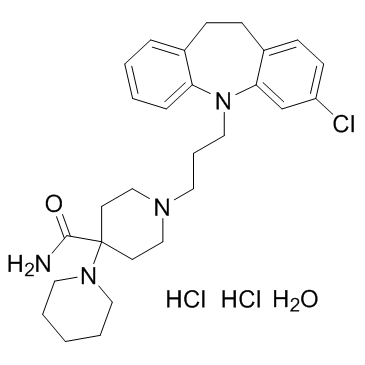Clocapramine hydrochloride hydrate (3-Chlorocarpipramine hydrochloride hydrate)
Modify Date: 2024-01-12 19:03:41

Clocapramine hydrochloride hydrate (3-Chlorocarpipramine hydrochloride hydrate) structure
|
Common Name | Clocapramine hydrochloride hydrate (3-Chlorocarpipramine hydrochloride hydrate) | ||
|---|---|---|---|---|
| CAS Number | 60789-62-0 | Molecular Weight | 572.010 | |
| Density | N/A | Boiling Point | N/A | |
| Molecular Formula | C28H41Cl3N4O2 | Melting Point | N/A | |
| MSDS | N/A | Flash Point | N/A | |
Use of Clocapramine hydrochloride hydrate (3-Chlorocarpipramine hydrochloride hydrate)Clocapramine hydrochloride hydrate is an antagonist of the D2 and 5-HT2A receptors. |
| Name | Clocapramine hydrochloride hydrate |
|---|---|
| Synonym | More Synonyms |
| Description | Clocapramine hydrochloride hydrate is an antagonist of the D2 and 5-HT2A receptors. |
|---|---|
| Related Catalog | |
| Target |
D2 receptor, 5-HT2A receptor[1]. |
| In Vivo | Clocapramine shows the lowest potency for D2-occupancy in vivo[1]. An in vivo receptor binding technique is used to evaluate the binding profiles of typical and atypical antipsychotic drugs to striatal dopamine-D2 and frontal serotonin-5-HT2 receptors in a rat brain using more specific ligands. Clocapramine produces ratios of potency in occupying 5-HT2 versus D2 receptors that fall between these two groups (ED50 of 14.5 mg/kg for D2, 4.9 mg/kg for 5-HT2)[2]. |
| Animal Admin | Rats[2] Male Wistar rats (210 to 240 g) are housed in a temperature-controlled room with a 12-hour dark/light cycle (lights on at 8:30) and have free access to food and water. For competition studies, rats are pretreated with an intraperitoneal injection of varying doses of antipsychotic drugs or the same volume (0.21 to 0.24 mL) of the corresponding vehicle (DMSO), 10 minutes prior to the injection of [3H]-YM-09151-2 or [3H]-ketanserin[2]. |
| References |
| Molecular Formula | C28H41Cl3N4O2 |
|---|---|
| Molecular Weight | 572.010 |
| Exact Mass | 570.229492 |
| [1,4'-Bipiperidine]-4'-carboxamide, 1'-[3-(3-chloro-10,11-dihydro-5H-dibenz[b,f]azepin-5-yl)propyl]-, hydrochloride, hydrate (1:2:1) |
| 3-Chloro-5-(3-(4-piperidino-4- carbamoylpiperidino)propyl)-10,11-dihydro-5H- dibenz(b,f)azepine dihydrochloride monohydrate |
| CLOCAPRAMINE DIHYDROCHLORIDE MONOHYDRATE |
| 1'-[3-(3-Chloro-10,11-dihydro-5H-dibenzo[b,f]azepin-5-yl)propyl]-1,4'-bipiperidine-4'-carboxamide dihydrochloride hydrate |